|
NMR In Porous Media
Nuclear magnetic resonance (NMR) in porous materials covers the application of using NMR as a tool to study the structure of porous media and various processes occurring in them. This technique allows the determination of characteristics such as the porosity and pore size distribution, the permeability, the water saturation, the wettability, etc. Theory of relaxation time distribution in porous media Microscopically the volume of a single pore in a porous media may be divided into two regions; surface area S and bulk volume V (Figure 1). The surface area is a thin layer with thickness \delta of a few molecules close to the pore wall surface. The bulk volume is the remaining part of the pore volume and usually dominates the overall pore volume. With respect to NMR excitations of nuclear states for hydrogen-containing molecules in these regions, different relaxation times for the induced excited energy states are expected. The relaxation time is significantly shorter for a molecu ... [...More Info...] [...Related Items...] OR: [Wikipedia] [Google] [Baidu] |
Porous Materials
A porous medium or a porous material is a material containing pores (voids). The skeletal portion of the material is often called the "matrix" or "frame". The pores are typically filled with a fluid (liquid or gas). The skeletal material is usually a solid, but structures like foams are often also usefully analyzed using concept of porous media. A porous medium is most often characterised by its porosity. Other properties of the medium (e.g. permeability, tensile strength, electrical conductivity, tortuosity) can sometimes be derived from the respective properties of its constituents (solid matrix and fluid) and the media porosity and pores structure, but such a derivation is usually complex. Even the concept of porosity is only straightforward for a poroelastic medium. Often both the solid matrix and the pore network (also known as the pore space) are continuous, so as to form two interpenetrating continua such as in a sponge. However, there is also a concept of closed porosi ... [...More Info...] [...Related Items...] OR: [Wikipedia] [Google] [Baidu] |
Physical Review A
''Physical Review A'' (also known as PRA) is a monthly peer-reviewed scientific journal published by the American Physical Society covering atomic, molecular, and optical physics and quantum information. the editor was Jan M. Rost (Max Planck Institute for the Physics of Complex Systems). History In 1893, the ''Physical Review'' was established at Cornell University. It was taken over by the American Physical Society (formed in 1899) in 1913. In 1970, ''Physical Review'' was subdivided into ''Physical Review A'', ''B'', ''C'', and ''D''. At that time section ''A'' was subtitled ''Physical Review A: General Physics''. In 1990 a process was started to split this journal into two, resulting in the creation of '' Physical Review E'' in 1993. Hence, in 1993, ''Physical Review A'' changed its statement of scope to ''Atomic, Molecular and Optical Physics.'' In January 2007, the section of ''Physical Review E'' that published papers on classical optics was merged into ''Physical Revie ... [...More Info...] [...Related Items...] OR: [Wikipedia] [Google] [Baidu] |
Resistivity Log
Resistivity logging is a method of well logging that works by characterizing the rock or sediment in a borehole by measuring its electrical resistivity. Resistivity is a fundamental material property which represents how strongly a material opposes the flow of electric current. In these logs, resistivity is measured using four electrical probes to eliminate the resistance of the contact leads. The log must run in holes containing electrically conductive mud or water, i.e., with enough ions present in the drilling fluid. Indeed, in the borehole fluids the electrical charge carriers are only ions (cations and anions) present in aqueous solution in the fluid. In the absence of dissolved ions, water is a very poor electrical conductor. Indeed, pure water is very poorly dissociated by its self-ionisation (at 25 °C, pKw = 14, so at pH = 7, += H–= 10−7 mol/L) and thus water itself does not significantly contribute to conduct electricity in an aqueous solution. The resis ... [...More Info...] [...Related Items...] OR: [Wikipedia] [Google] [Baidu] |
Formation Factor
In petrophysics, Archie's law relates the ''in-situ'' electrical conductivity (C) of a porous rock to its porosity (\phi\,\!) and fluid saturation (S_w) of the pores: :C_t = \frac C_w \phi^m S_w^n Here, \phi\,\! denotes the porosity, C_t the electrical conductivity of the fluid saturated rock, C_w represents the electrical conductivity of the aqueous solution (fluid or liquid phase), S_w is the water saturation, or more generally the fluid saturation, of the pores, m is the cementation exponent of the rock (usually in the range 1.8–2.0 for sandstones), n is the saturation exponent (usually close to 2) and a is the tortuosity factor. Reformulated for the electrical resistivity (R), the inverse of the electrical conductivity (R = \frac), the equation reads :R_t = a R_w \phi^ S_w^ with R_t for the total fluid saturated rock resistivity, and R_w for the resistivity of the fluid itself (w meaning water or an aqueous solution containing dissolved salts with ions bearing elec ... [...More Info...] [...Related Items...] OR: [Wikipedia] [Google] [Baidu] |
Tortuosity
Tortuosity is widely used as a critical parameter to predict transport properties of porous media, such as rocks and soils. But unlike other standard microstructural properties, the concept of tortuosity is vague with multiple definitions and various evaluation methods introduced in different contexts. Hydraulic, electrical, diffusional, and thermal tortuosities are defined to describe different transport processes in porous media, while geometrical tortuosity is introduced to characterize the morphological property of porous microstructures. Tortuosity in 2-D Subjective estimation (sometimes aided by optometric grading scales) is often used. The simplest mathematical method to estimate tortuosity is the arc-chord ratio: the ratio of the length of the curve (''C'') to the distance between its ends (''L''): :\tau = \frac Arc-chord ratio equals 1 for a straight line and is infinite for a circle. Another method, proposed in 1999, is to estimate the tortuosity as the integral o ... [...More Info...] [...Related Items...] OR: [Wikipedia] [Google] [Baidu] |
Kozeny–Carman Equation
The Kozeny–Carman equation (or Carman–Kozeny equation or Kozeny equation) is a relation used in the field of fluid dynamics to calculate the pressure drop of a fluid flowing through a packed bed of solids. It is named after Josef Kozeny and Philip C. Carman. The equation is only valid for creeping flow, i.e. in the slowest limit of laminar flow. The equation was derived by Kozeny (1927) and Carman (1937, 1956) from a starting point of (a) modelling fluid flow in a packed bed as laminar fluid flow in a collection of curving passages/tubes crossing the packed bed and (b) Poiseuille's law describing laminar fluid flow in straight, circular section pipes. Equation The equation is given as: :\frac = - \frac\fracu_\mathrm where: *\Delta p is the pressure drop; *L is the total height of the bed; *u_\mathrm is the superficial or "empty-tower" velocity; *\mu is the viscosity of the fluid; *\epsilon is the porosity of the bed; *\mathit_\mathrm is the sphericity of the particles ... [...More Info...] [...Related Items...] OR: [Wikipedia] [Google] [Baidu] |
Geophysics (journal)
''Geophysics'' is a bimonthly peer-reviewed scientific journal covering all aspects of research, exploration, and education in applied geophysics. It was established in 1936 and is published by the Society of Exploration Geophysicists. The current editor-in-chief is Jeffrey Shragge (Colorado School of Mines). According to the ''Journal Citation Reports'', the journal has a 2018 impact factor of 2.793. See also * List of scientific journals in earth and atmospheric sciences A ''list'' is any set of items in a row. List or lists may also refer to: People * List (surname) Organizations * List College, an undergraduate division of the Jewish Theological Seminary of America * SC Germania List, German rugby union ... References External links * {{Official website, http://library.seg.org/journal/gpysa7 Geophysics journals English-language journals Publications established in 1936 Academic journals published by learned and professional societies Bimonthly journal ... [...More Info...] [...Related Items...] OR: [Wikipedia] [Google] [Baidu] |
Geometric Mean
In mathematics, the geometric mean is a mean or average which indicates a central tendency of a set of numbers by using the product of their values (as opposed to the arithmetic mean which uses their sum). The geometric mean is defined as the th root of the product of numbers, i.e., for a set of numbers , the geometric mean is defined as :\left(\prod_^n a_i\right)^\frac = \sqrt /math> or, equivalently, as the arithmetic mean in logscale: :\exp For instance, the geometric mean of two numbers, say 2 and 8, is just the square root of their product, that is, \sqrt = 4. As another example, the geometric mean of the three numbers 4, 1, and 1/32 is the cube root of their product (1/8), which is 1/2, that is, \sqrt = 1/2. The geometric mean applies only to positive numbers. The geometric mean is often used for a set of numbers whose values are meant to be multiplied together or are exponential in nature, such as a set of growth figures: values of the human population or int ... [...More Info...] [...Related Items...] OR: [Wikipedia] [Google] [Baidu] |
SPE Advanced Technology Series
SPE may refer to: Science and technology * Spe (planet), 14 Andromedae b * Serum protein electrophoresis * Solar particle event,generating very high energy protons * Solid phase extraction, from a mixture * Solid-phase epitaxy, from amorphous to crystalline * ''The Sound Pattern of English'', a 1968 book by Noam Chomsky and Morris Halle * Stanford prison experiment, in psychology * Synchronous payload envelope, in synchronous optical networking * SpE, abbreviation for Sporadic E propagation Computer science * Synergistic Processing Element in the Cell microprocessor * Signal-Processing Engine, for example in the PowerPC e500 * Single-Pair Ethernet Organizations * Sauber Petronas Engineering, car engine manufacturer * Societas Privata Europaea, a Europe-wide type of limited company * Sony Pictures Entertainment, a US company * SPE, later Luminus (company) * Special Police Establishment, later Central Bureau of Investigation, India * Special purpose entity, for a specific ... [...More Info...] [...Related Items...] OR: [Wikipedia] [Google] [Baidu] |
Diffusion
Diffusion is the net movement of anything (for example, atoms, ions, molecules, energy) generally from a region of higher concentration to a region of lower concentration. Diffusion is driven by a gradient in Gibbs free energy or chemical potential. It is possible to diffuse "uphill" from a region of lower concentration to a region of higher concentration, like in spinodal decomposition. The concept of diffusion is widely used in many fields, including physics (particle diffusion), chemistry, biology, sociology, economics, and finance (diffusion of people, ideas, and price values). The central idea of diffusion, however, is common to all of these: a substance or collection undergoing diffusion spreads out from a point or location at which there is a higher concentration of that substance or collection. A gradient is the change in the value of a quantity, for example, concentration, pressure, or temperature with the change in another variable, usually distance. A change in c ... [...More Info...] [...Related Items...] OR: [Wikipedia] [Google] [Baidu] |
Surface-to-volume Ratio
The surface-area-to-volume ratio, also called the surface-to-volume ratio and variously denoted sa/vol or SA:V, is the amount of surface area per unit volume of an object or collection of objects. SA:V is an important concept in science and engineering. It is used to explain the relation between structure and function in processes occurring through the surface ''and'' the volume. Good examples for such processes are processes governed by the heat equation, i.e., diffusion and heat transfer by conduction. SA:V is used to explain the diffusion of small molecules, like oxygen and carbon dioxide between air, blood and cells, water loss by animals, bacterial morphogenesis, organism's thermoregulation, design of artificial bone tissue, artificial lungs and many more biological and biotechnological structures. For more examples see Glazier. The relation between SA:V and diffusion or heat conduction rate is explained from flux and surface perspective, focusing on the surface of a body ... [...More Info...] [...Related Items...] OR: [Wikipedia] [Google] [Baidu] |
Magnetization
In classical electromagnetism, magnetization is the vector field that expresses the density of permanent or induced magnetic dipole moments in a magnetic material. Movement within this field is described by direction and is either Axial or Diametric. The origin of the magnetic moments responsible for magnetization can be either microscopic electric currents resulting from the motion of electrons in atoms, or the spin of the electrons or the nuclei. Net magnetization results from the response of a material to an external magnetic field. Paramagnetic materials have a weak induced magnetization in a magnetic field, which disappears when the magnetic field is removed. Ferromagnetic and ferrimagnetic materials have strong magnetization in a magnetic field, and can be ''magnetized'' to have magnetization in the absence of an external field, becoming a permanent magnet. Magnetization is not necessarily uniform within a material, but may vary between different points. Magnetizat ... [...More Info...] [...Related Items...] OR: [Wikipedia] [Google] [Baidu] |




